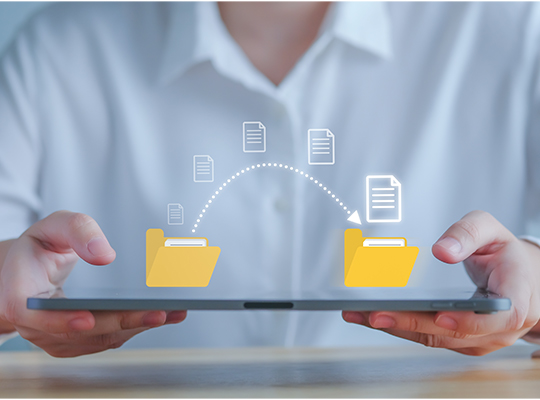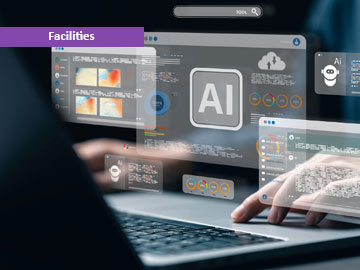Overcoming the Paper Chase with IDP
In today's digital age, organizations generate and store vast amounts of data within documents. But extracting this information manually is a time-consuming and error-prone process. This is where Intelligent Document Processing (IDP) and AI-powered Data Extraction come in.
IDP leverages the power of Artificial Intelligence (AI) to automate document processing tasks. It can handle a wide range of document types, including invoices, contracts, emails, and more. Here's what IDP can do for you:
- Automated Data Extraction: Extract key data points from your documents with high accuracy, eliminating manual data entry and reducing errors.
- Improved Efficiency: Automate repetitive tasks and free up your team to focus on more strategic work.
- Enhanced Decision-Making: Gain valuable insights from your data faster to make informed business decisions.
- Reduced Costs: Save time and money by streamlining document processing workflows.
Success Stories
IDP: A Multi-Tool Approach to Data Extraction
The world of documents can be a messy one. From invoices to contracts, applications to medical records, businesses deal with a vast array of document types. But extracting the valuable data trapped within them? That's where Intelligent Document Processing (IDP) comes in.
IDP isn't a one-size-fits-all solution. It utilizes a combination of intelligent technologies to tackle different document processing challenges. Here's a glimpse into the diverse toolbox of IDP:

Template-Based Extraction:
- Ideal for standardized documents with consistent layouts (e.g., invoices, purchase orders).
- Uses pre-defined templates to identify specific data points within the document structure.
- Offers high accuracy and efficiency for repetitive document types.

Form Processing:
- Specifically designed for extracting data from structured forms like applications or surveys.
- Leverages pre-defined fields and layouts to capture information accurately.
- Simplifies data collection and reduces the need for manual form processing.

Document Classification:
- Analyzes incoming documents and categorizes them based on type (e.g., invoice, contract, email).
- Routes documents to the appropriate workflow for efficient processing.
- Saves time and resources by eliminating manual document sorting.

Machine Learning Extraction:
- Uses AI algorithms to learn and adapt to document variations.
- Extracts data from semi-structured and unstructured documents (e.g., emails, reports).
- Continuously improves accuracy over time as it processes more documents.

Text Analytics and Natural Language Processing (NLP):
- Goes beyond simple data extraction, analyzing the context and meaning within documents.
- Identifies key concepts and sentiment from textual content.
- Enables deeper insights to be gleaned from document analysis.
Demo Videos
Intelligent data processing (IDP) has the potential to revolutionize the future of work by automating tedious tasks, extracting insights and predicting future trends. With IDP, businesses can
- Decode hidden opportunities & Streamline operations
- Personalize customer experiences & Fuels innovation
Businesses that embrace IDP gain a significant edge, transforming from data-rich to data-driven for a more successful future.

Unlock the Power of Your Documents
Whether you have standardized invoices or complex reports, IDP offers a suite of tools to meet your specific needs. With AI Document Extraction and Automated Document Processing, you can:
- Free your team from tedious manual data entry.
- Reduce errors and inconsistencies in your data.
- Streamline workflows and improve processing efficiency.
- Gain valuable insights from your documents faster than ever.
IDP – The Game Changer

50%
reduction in processing time

30-200%
increase in ROI

52%
reduction in errors

99%
accuracy rate

70%
enhanced productivity
Intelligent Document Processing Services
Intelligent Document Processing (IDP) services are essentially solutions that utilize AI and machine learning to automate the extraction of data from various documents. These services can handle a wide range of document types, from invoices and contracts to emails and social media posts. IDP automates the process of extracting key information from documents, eliminating the need for manual data entry saving time, reducing errors, and improving efficiency.
Web Scraping: Harvesting Web-based Data
It using automated bots to collect data from websites for gathering publicly available information such as product prices, reviews, and social media trends. Here’s how it works:
- Automated bots navigate through web pages.
- Data is extracted from HTML tags and stored in a structured format.
- Intelligent capture techniques enable accurate data retrieval.
The ability to capture vast amounts of data efficiently makes web scraping an invaluable tool for many industries, including e-commerce, finance, and marketing.


APIs: Accessing Data Programmatically
APIs provide a standardized way to access data programmatically and to interact with external systems and retrieve data seamlessly. By using APIs, organizations can:
- Access real-time data from various sources.
- Integrate data into their applications effortlessly.
- Ensure data accuracy and consistency.
APIs are indispensable for tasks like integrating weather data into mobile apps, accessing financial data for trading, or retrieving social media feeds for analysis.
Database Extraction: Retrieving Structured Data
Database extraction involves querying databases to fetch specific information widely used in various applications, including:
- Customer relationship management (CRM) systems.
- Business intelligence (BI) tools.
- Data warehousing solutions.
Database extraction ensures that data is retrieved accurately and efficiently, making it a pillar of modern data-driven decision-making processes.


Text Mining: Analyzing Unstructured Data
Text mining is a powerful technique for extracting insights from unstructured text data. It uses various natural language processing (NLP) methods to analyze and interpret large volumes of text. Key applications include:
- Sentiment analysis of customer reviews and feedback.
- Topic modeling to identify emerging trends.
- Named entity recognition for extracting specific information.
By leveraging intelligent capture and text mining, organizations can transform raw text data into valuable business insights.
ETL: Extract, Transform, Load
ETL is a comprehensive data extraction used to consolidate data from multiple sources into a single, unified view and has 3 steps:
- Extract: Data is retrieved from various sources, including databases, web services, and files.
- Transform: Data is cleaned, transformed, and formatted to meet specific requirements.
- Load: The processed data is loaded into a target system, such as a data warehouse.
It is a comprehensive and reliable data repository for business intelligence and analytics.


Screen Scraping: Extracting Data from Legacy Systems
Screen scraping, also known as terminal scraping, involves extracting data from the screen output of legacy systems when direct database access is not possible. It helps to:
- Access data from older, non-integrated systems.
- Automate data entry processes.
- Improve data accuracy by reducing manual entry errors.
While screen scraping may seem outdated, it remains a viable option for organizations with legacy infrastructure.
Document Parsing: Extracting Data from Files
Document parsing involves extracting data from various types of documents, such as PDFs, Word files, and scanned images. This technique is particularly useful for:
- Automating document processing workflows.
- Extracting key information from invoices, contracts, and forms.
- Improving data accessibility and usability.
Intelligent capture methods, such as OCR, play a crucial role in accurately parsing and extracting data from documents.


Robotic Process Automation (RPA): Automating Data Extraction
RPA bots mimic human actions and interact with digital systems to retrieve information helping to:
- Reduce manual workload and operational costs.
- Enhance data accuracy and consistency.
- Enable 24/7 data extraction capabilities.
By integrating intelligent capture with RPA, organizations can streamline their data extraction processes and achieve greater operational efficiency.
You may be interested



Escaping the common pitfalls of data challenges in the banking sector with Master Data…
Blog
Getting insights from your documents a challenge?














